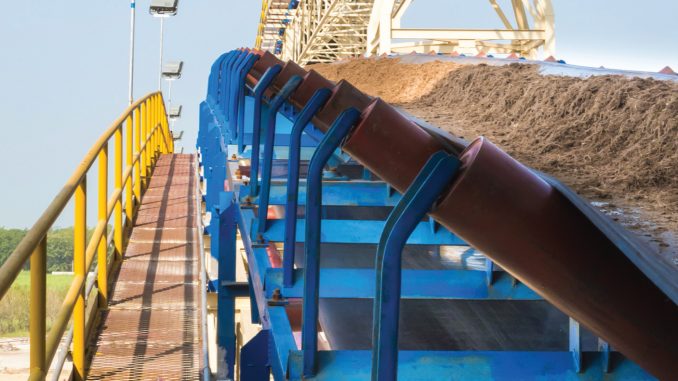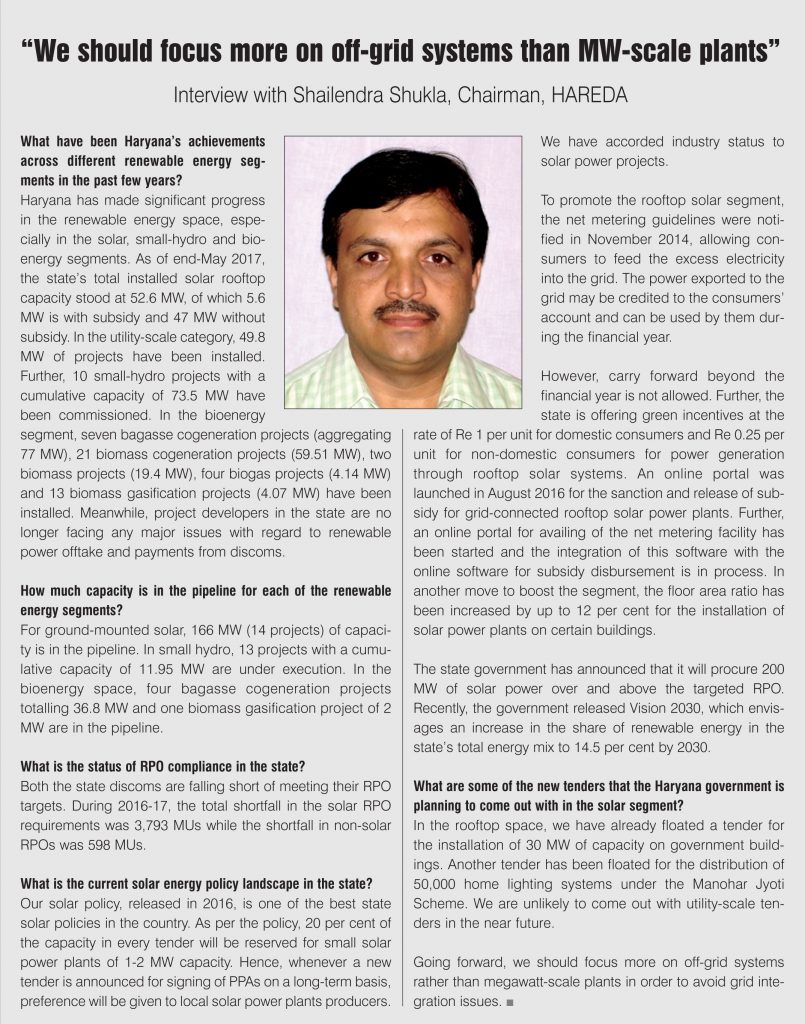
Haryana is one of the high per capita electricity consumption states in the country. It is also among the few states that have achieved 100 per cent village electrification. The power portfolio of the state is critically dominated by coal-based thermal power generation with a share of around 75 per cent, followed by hydro (15.9 per cent) and gas-based thermal power (6.1 per cent). Renewable energy sources account for less than 2 per cent of the total installed capacity in the state and the scope of renewable energy development is limited mainly to the bioenergy and solar segments.
With a potential of 1,707 MW, comprising 1,333 MW of biomass, 350 MW of bagasse-based cogeneration and 24 MW of waste-to-energy, Haryana is one of the leading bioenergy states since agriculture is the state’s mainstay and leading occupation. In the solar space, the state holds a potential of 4.56 GW. It also has a small-hydro potential of 110 MW.
As of end-May 2017, the installed solar, small-hydro and bioenergy capacities in the state stood at 102.4 MW, 73.5 MW and 164.12 MW respectively. Although the current share of renewables in the state’s energy mix is low, the government is keen to tap the renewable power potential, particularly solar and biomass power, to meet the growing demand for power in an environment-friendly and sustainable manner. The need to increase the share of renewables in the total energy mix is further reinforced by the fact that Haryana’s power demand varies considerably between the paddy season (from June to September) and the rest of the year. During the paddy season, the demand reaches its peak, but reduces to less than half during the remaining months. Thus, the state will have to plan its power situation in a measured way so that the peak demand is met while the surplus in energy availability is minimised. This can be achieved by giving more preference to renewable sources for power generation.
Solar power
Over the past few years, Haryana has witnessed subdued growth in the solar power segment due to the unavailability of land, which has slowed down the development of low-cost utility-scale solar energy projects. The government has therefore shifted its focus towards the rooftop segment, which now accounts for around 52 per cent of the total installed solar energy capacity. It provides financial assistance for the installation of grid-connected rooftop solar power plants at the rate of 30 per cent of the cost/benchmark cost or Rs 20,000 per kW, whichever is less, for the residential, institutional and social sectors. Further, the government has made it mandatory for all buildings on plots of 500 square metres or more to install rooftop solar power systems, which will bear 3-5 per cent of the current connected load. The state government has recently issued a notification directing all authorities to appoint nodal officers for the strict implementation of the scheme at buildings, including residential ones. According to the notification, the Haryana Urban Development Agency will issue occupancy certificates for buildings on plot sizes of 500 square metres and above only after seeing the certificate for the installation of a solar power plant. The government has also decided to install rooftop solar plants on government school buildings across the state in the next few months.
In addition, Haryana released a new solar power policy in 2016, which superseded the earlier policy released in 2014. The 2016 policy provides a number of benefits and incentives, including streamlining the clearance procedure, to encourage investments in the solar power segment and make the business environment more conducive for developers. For instance, the policy has waived electricity taxes and cess, electricity duty, wheeling charges, cross-subsidy charges, transmission and distribution charges, and surcharges for ground-mounted as well as rooftop solar projects. Further, all new megawatt-scale projects will be given the incentives available to industrial units under the state’s industrial policy. Moreover, these projects will not be required to obtain any change of land use approval, and will be exempted from external development charges, scrutiny fee and infrastructure development charges. Also, no clearance will be required from the Haryana Pollution Control Board.
In addition, developers of ground-mounted megawatt-scale projects have been allowed to use the space between installed solar panels for commercial floriculture/ horticulture-related activities, provided it does not affect solar power generation. The policy also offers a price preference to independent power producers (IPPs) looking to set up plants in the state. In addition, the state distribution licensees can permit banking of solar power generated by eligible producers. The banking facility will be allowed for a period of one year and IPPs will pay the difference of unscheduled interchange charges at the time of injection and at the time of withdrawal.
The state government is also implementing a solar water pump scheme, under which it is offering a 90 per cent subsidy to farmers for solar pumps of 2 HP DC (surface type), 2 HP DC (submersible type) and 5 HP AC (submersible type). The rest of the cost will be shared between the central government and the state government.
Haryana has raised its solar renewable purchase obligation (RPO) targets from 3 per cent to 8 per cent by 2021-22. This will result in the installation of 3,200 MW of solar capacity by 2021-22. The state’s power utilities are in the process of inviting tenders for the purchase of 300 MW of solar capacity in the utility-scale segment. Further, tenders for the installation of 125 MW of solar power projects have been initiated by IPPs. Meanwhile, the Ministry of New and Renewable Energy has selected Gurgaon and Faridabad for its solar cities programme.
Bioenergy
While the state’s bagasse-based cogeneration potential has been tapped fairly well, the same has not been achieved in the biomass-based power generation segment. This can be attributed to the lack of a separate sector-specific policy and low biomass tariffs, which were last revised in 2014.
In 2012, the Haryana Renewable Energy Development Agency (HAREDA) signed MoUs with four private players for setting up five biomass power projects with an aggregate capacity of 51 MW. Of the five projects, two have already been commissioned and the remaining are currently under implementation. The state’s first biomass project, with a capacity of 9.9 MW, was set up in Mohindergarh district in May 2013. However, the project, developed by Starwire India Vidyut Private Limited, remained stalled for several years on account of issues related to regulatory processes and fuel logistics. The second project of 9.5 MW was commissioned in 2014, in Dhana Narsan village of Bhiwani district, by Jyoti Renewable Energy Private Limited.
The biomass segment in Haryana is governed by the state’s renewable energy policy released in 2005. Some of the incentives offered for the segment under the policy are exemption from electricity duty and local area development tax on plant, machinery and equipment. Further, as per the policy, the state government will acquire land, if necessary, at the cost of the biomass power producer if a request to that effect is made. Moreover, the policy permits setting up of biomass projects in agricultural zones without any levy of conversion charges.
Going forward, the Haryana Renewable Energy Development Agency (HAREDA) is planning to float a request for proposal for approximately 20 MW of biogas-based power projects on a build-own-operate basis in various districts of the state. These projects are proposed to be set up based on the digestion route using animal waste/suitable biomass such as paddy straw as feed material. The project capacity will range from 500 kW to 5 MW. Further, HAREDA will allocate the projects through the competitive bidding route considering the HERC tariff as the ceiling tariff and offering discount on this tariff.
The way forward
Over the past two years, Haryana has experienced no peak power shortage and less than 1 per cent energy shortage. However, the state is poised to witness a significant rise in power demand owing to a further increase in the number of electrified households and average consumption per household. In order to meet this increasing demand, the state has already planned additional capacity through its own generating stations, renewable energy sources and central generating stations as well as medium/long-term power purchase agreements (PPAs) under the competitive bidding mechanism.
As per the state’s generation plan, a capacity of around 1,484.56 MW is expected to be added by 2018-19 from new state and central sector projects as well as IPP projects. Of this, about 549 MW will be from non-conventional energy sources and 935.56 MW from conventional sources. As such, the total installed capacity is expected to reach 12,609.1 MW by 2018-19 – 11,905.7 MW of conventional and 703.4 MW of renewable power. The state’s recently released Vision 2030 document also envisages an increased share of renewables in the total energy mix to 14.5 per cent by 2030, taking its installed renewable energy capacity to 9,000 MW.



